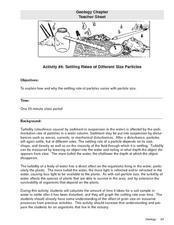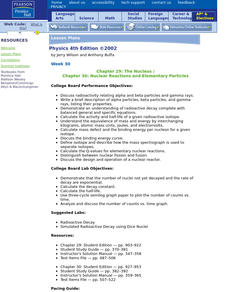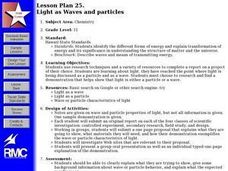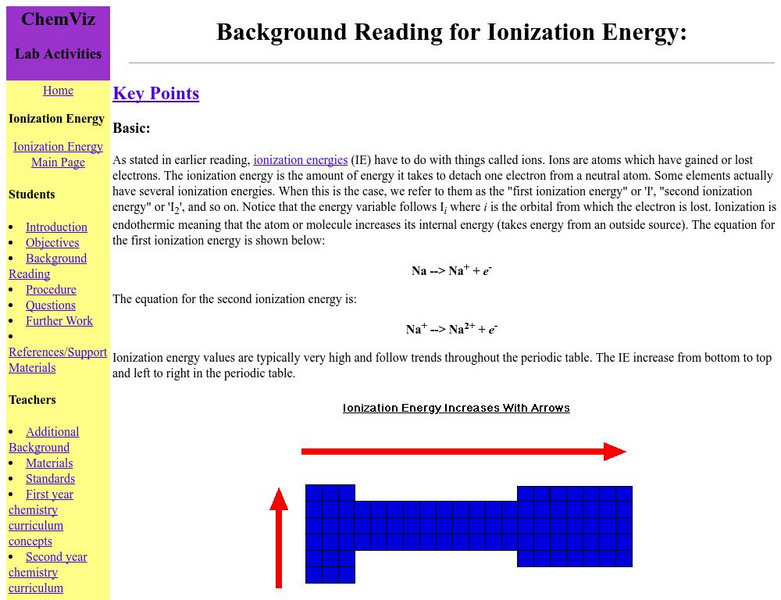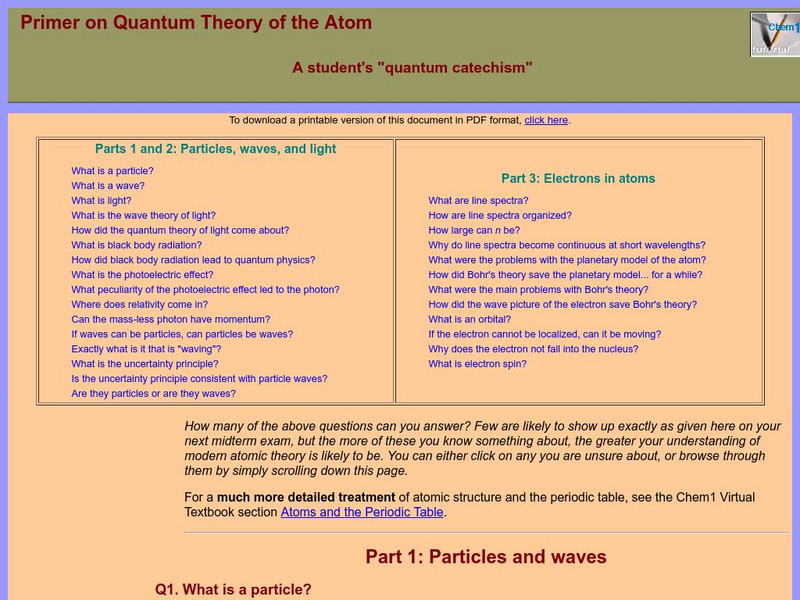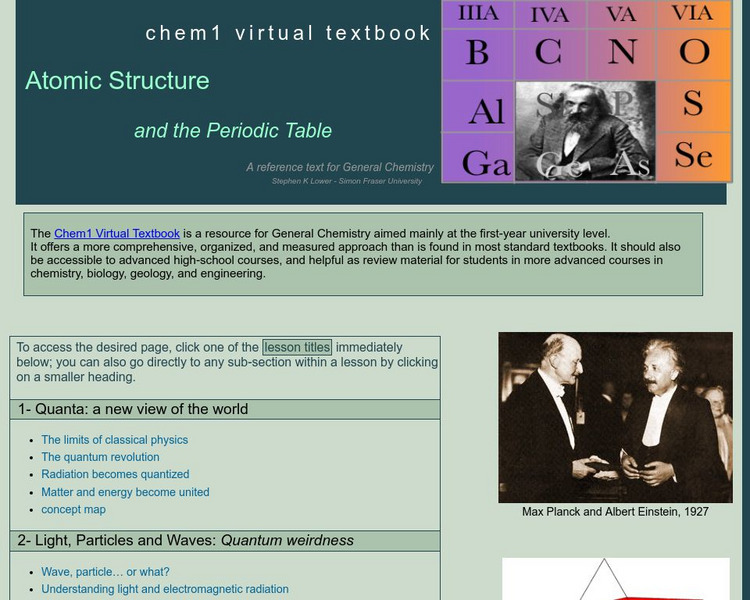Curated OER
Energy Source
Sixth graders work in groups. They are given one type of energy to research. Students look through the different magazines or newspapers to identify pictures that show their type of energy. Students glue their pictures to the...
Curated OER
Indoor Air Pollutant Sensing LAB: Peppermint Diffusion
Pupils engage in an experiment for the scientific concept of diffusion of particles. There are instructions for classroom set up prior to conduction of the activity. Students sit in the classroom that is filled with the smell of...
Curated OER
Determine Soil Particle Size
Students examine various soil samples in groups. Using the samples, they identify the characteristics of them and calculate percolation and infiltration rates. They use this information to discover why some species can survive in one...
Curated OER
Settling Rates of Different Size Particles
Students discover how and why the settling rate of particles differs with the size of the particles. Using different soil samples, they calculate the amount of time it takes for a sample to settle in water for up to forty minutes. They...
Curated OER
Introducing Particles
Students predict what is going to happen using prior knowledge being prepared to alter a view when faced with new evidence. They then accurately measure and record liquid volumes realizing that liquids and granular solids have...
Curated OER
The Wind-Up and the Pitch
Students consider how sound affects one's experience at a ballpark and the ways that the acoustics at a baseball stadium might be improved. Students then recommend their own designs for a "soundly built" baseball stadium.
Curated OER
The Nucleus / Nuclear Reactions and Elementary Particles
Students describe how radioactivity relates to alpha and beta particles. Using their properties, they write a descriptive paper about the gamma rays and alpha and beta particles. They calculate q-values and the half-life of a given...
Curated OER
Water Flow Through Local Soils
Learners examine the relationship between particle size and rate of water flow through soil. They collect soil samples, make predictions, conduct a water flow experiment, analyze the data, and answer conclusion questions.
Curated OER
Particles & Accelerators
Young scholars discover the basic information about particles and accelerators. They examine a diagram with particles that describes their masses and charges. They research the history of physics from the time of the Greeks.
Curated OER
Light as Waves and Particles
Eleventh graders explore the wave and particle properties of light.
Centers for Disease Control and Prevention
Centers for Disease Control: Atsdr: Beryllium
Information on beryllium and beryllium exposure disease for those who need information due to possible exposure at work.
Centers for Disease Control and Prevention
Centers for Disease Control: Atsdr: Cadmium
Detailed question and answer format site with information on cadmium exposure and its health effects. Very readable.
Shodor Education Foundation
Shodor: Background Reading for Ionization Energy
A very complete lesson on ionization energy, including tables and charts to illustrate the ideas presented in the text.
University of Colorado
University of Colorado: Ph Et Interactive Simulations: Quantum Wave Interference
When do photons, electrons, and atoms behave like particles and when do they behave like waves? In this interactive, use quantum detectors to explore how measurements change the waves and the patterns they produce on the screen.
University of Colorado
University of Colorado: Ph Et Interactive Simulations: Quantum Bound States
Explore the properties of quantum particles bound in potential wells, and see how the wave functions and probability densities that describe them evolve (or don't evolve) over time.
Simon Fraser University
Chem1 Virtual Textbook: Primer on Quantum Theory of the Atom
Covering a range of topics related to the quantum theory of the atom, this site provides a three-part dissection of atomic theory including information on particles, waves, light, electrons, and atoms.
Simon Fraser University
Chem1 Virtual Textbook: Atoms and the Periodic Table
As part of the General Chemistry Virtual Textbook, this site examines a list of related topics (in hyperlink format) on the atom and the Periodic Table of elements. Topics from light, particles, and waves to the Bohr model, quantum...
Cornell University
Cornell University: How to Build a Cloud Chamber
A very interesting site by university physicist Andrew Foland on how to build a cloud chamber. Includes all the how-to-build information and a materials list as well as a discussion of how to use the cloud chamber and what you should see.
NASA
Nasa Earth Observatory: Natural Hazards: Dust, Smoke, and Haze
NASA's Earth Observatory offers photographs of dust, smoke, and haze throughout the world. Learn how these pollutants can be hazardous to our Earth.
NASA
Nasa Earth Observatory: Global Maps: Aerosol Optical Depth
View Earth's aerosol optical depth by watching a global map evolve from January 2005 to November 2008. Learn about aerosol amounts such as volcanic ash, sea salt, smoke, and other pollutants.
Chiral Publishing
Chiral Publishing: An Introduction to Chemistry: Nuclear Chemistry: Audio Book
Learn about nuclear energy as you listen to the audio book describing nuclear chemistry. View maps, examples, graphs, and pictures describing everything from electrons to beta emissions and more.
Concord Consortium
Concord Consortium: Molecular View of a Gas
This simulation allows students to make observations about the structure and movement of particles in a gas.
Frostburg State University
Frostburg State University Chemistry Online: Polyatomic Ions
A good reference page for anyone studying polyatomic ions. Tables included on this page organize polyatomic ions by family and by charge. Information on naming compounds with polyatomic ions is also provided. There is a link to an online...
Utah Education Network
Uen: Expansion and Contraction of Materials
Lesson demonstrates how materials expand and contract with heat.





